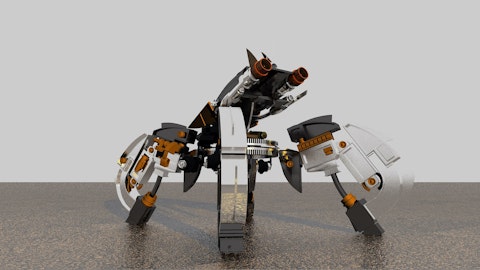Operator: And we move to a question from Damian Karas from UBS. Damian, please go ahead.
Damian Karas: Hi, good morning everyone.
Bill Burns: Good morning, Damian.
Damian Karas: Good morning. So not to beat a dead horse here on the demand environment and recovery. But Bill mentioned not seeing signs of that as you think about early 2024, I get that you’re seeing that based on your order patterns, but based on your customer conversations, I mean, what do you think it’s going to take to see that inflection of demand to drive that? And where would you see it first? Thinking about the various markets you play in and your diverse set of customers?
Bill Burns: Yes. What I’d say is that overall, we’d have to see strengthening certainly of a goods based economy. And our customers overall will resume deployments as they — some of the macroeconomic uncertainty around the good based economy abates. And in T&L and e-commerce, we’ve seen significant capacity built out during the pandemic and that excess capacity has to be used within their environment. And that’s across their entire environment where we’ve built that capacity that now is more being used and demand is more normalized levels than the accelerated levels through the pandemic. I would say overall, when we see the broader demand across the industry, we’re seeing that where first, likely large customers first is what we’d expect that large customers, the first area where we saw it challenging from a demand environment, so we’d expect that to return first. And then from their midsize and run rate would follow. I don’t know, Joe, if you want to add anything.
Joachim Heel: Yes. Maybe just a little bit on that point. During the supply-constrained phase, we had given some priority to some of our larger customers. So that’s where a large amount of the volume and the capacity that went into the market went. And that’s where we’re seeing the steepest declines at this point. So I would expect that, that’s also where we would see the first signs of recovery where those customers would begin purchasing again. And we are staying very close to those large customers as we’re seeing them sweat their assets longer, we know exactly when they are reaching those points in the product life cycle where they will need to refresh. And we’re working with them on plans that will fit their budgets. And you can imagine, as we’re going into 2024, they’re coming up with new budgets and we’re working with them on doing that. So that’s perhaps where I would look first.
Damian Karas: Got it. That’s really helpful. And then maybe if we could switch gears and talk about gross margins. Curious how you are thinking about what those look like from here, is there a further downside from the third quarter just based on the volume levels you’re seeing? And how should we think about the kind of the new baseline or normalized gross margin?
Nathan Winters: Yes, Damian. So if you look just maybe for context on Q3 gross margin, obviously, down year-on-year by about one point to 44.8%, volume deleveraging was a major driver of the decline as we did see favorability in premium supply chain costs. Now that those are entirely mitigated. So that was a two-point favorable impact as well as we’re seeing nice traction from the pricing actions we’ve taken over the last several years and continued to strengthen our service and software margins. So if we look at our underlying gross margins with the pricing actions we’ve taken to offset component cost increases, inflation with the freight cost declining. Really now the focus is on rebalancing our manufacturing and distribution capacity to the lower volumes so that we can again, start to see those margins recover as we go into next year.
So I think the — as we look here at the second half is the low watermark just given the sharp volume declines and making sure we reset capacity to that while giving us flexibility to grow as the market recovers.
Operator: We now have a question from Keith Housum from Northcoast Research. Keith, please go ahead.
Keith Housum: Thank you. Good morning guys. If you perhaps focus a little bit on Zebra’s own inventory levels, which obviously are still high compared to historical levels. Is this more component cost product parts, or is it more finished goods? And then second to that is, do you guys have minimum purchase agreements with your OEMs where if you’re not making the minimum purchases, you’re going to have penalties you’ll incur?
Nathan Winters: Keith, so just on our own inventory, as expected, our inventory balances stayed relatively flat to where we were at the end of the second quarter. We don’t expect to see a material change as we exit the year. And as we said before and as you stated, the primary increase from where we’d expect to be is all around component — consigned components that are at our Tier 1 manufacturers. So these are inventory that we made purchase commitments on going back to a year, 1.5 year ago at really the peak demand as well as the peak supply chain challenges and issues where the lead times were out greater than a year. So really absorbing those inbound components as our demand decrease. I think the team has done a phenomenal job working with all of our partners to reduce those purchase commitments.
If you look at our outstanding purchase commitments, we’ve cut those in half since the beginning of the year. We’ve driven down finished good balance since the beginning of the year. So we’re making traction, although you don’t see it in the headline numbers. So really now, it’s around getting stability in the demand signal to our suppliers so that we can in right size those inbound components. If you — to your last question, we don’t have a minimum purchase agreement that it has penalties. Obviously, we work with our Tier 1 manufacturers to have different tiering in terms of volume on our purchase price to cover their overhead. But there’s not a, I’d say, a penalty per se at certain volumes, it’s just making sure that they have the right capacity within their cost structure.
Keith Housum: Okay. If I could follow-up on that. And as we look forward to like 2024, is there a rule of thumb or where do you think your inventory level should be under optimal level? Because, of course, we’d assume that you’ll have some positive free cash flow next year as that gets worked down?
Nathan Winters: Yes. So I would say, if you look at base, if you go back to our historical turns and you account for some of the M&A over the past couple of years, we said about a $200 million reduction would get us back to say, normalized levels. When and how quickly we can achieve that is the question. And some of that depends on, again, some of the demand stability as we go into next year. But that $200 million reduction would be entirely in consigned inventory components at our manufacturers.
Operator: We’ll take a question now from Joe Giordano from TD Cowen. Joe, please go ahead.
Joseph Giordano: Hey, good morning guys.
Bill Burns: Good morning, Joe.
Joseph Giordano: So I’ll ask a couple of higher, bigger picture kind of questions. We’ve dug into the near term dynamics quite a bit here. I’ve had a lot of questions about like longer term, what is a shift from potentially into kind of fixed automation mean for you guys? So you have huge share in mobile computers. And then what happens as you get more and more of these kind of big RFID-type fixed mounted scanners instead of having a person make scans. Like what does that mean for you over time if the percentage of scans being done by humans goes down?




